Pondicherry officially changed its name into Puducherry in September 2006, which means only a little more than a year before my friend Sneža and I came to this city. For this reason, during my travel I used the old name of the city all the time, but now in my story I have decided to use the “new” name.
This was the capital of the French colonies in India de facto until 1954 (de jure until 1962), so that even today there is a strong influence of the French culture: the streets often have French names (Rue de ...), the restaurants offer some French dishes (and have menus in French), the architecture is somewhat different in comparison to the other parts of India, etc.
In Puducherry we stayed at a boarding house and in the evening upon our arrival we went for a short walk around the area. Actually, we first went for dinner and later for a stroll by the sea with an incredibly translucent sky dominated by the full Moon that reflected in the waters of the Bay of Bengal. We also agreed the taxi service for the following day.
Still, the next day, after breakfast, we first went for a short sightseeing walk around the city. Since the boarding house was in the very centre, in a street parallel to the walking strip by the Bay of Bengal, we soon reached the Church of Our Lady of Angels built in 1855.
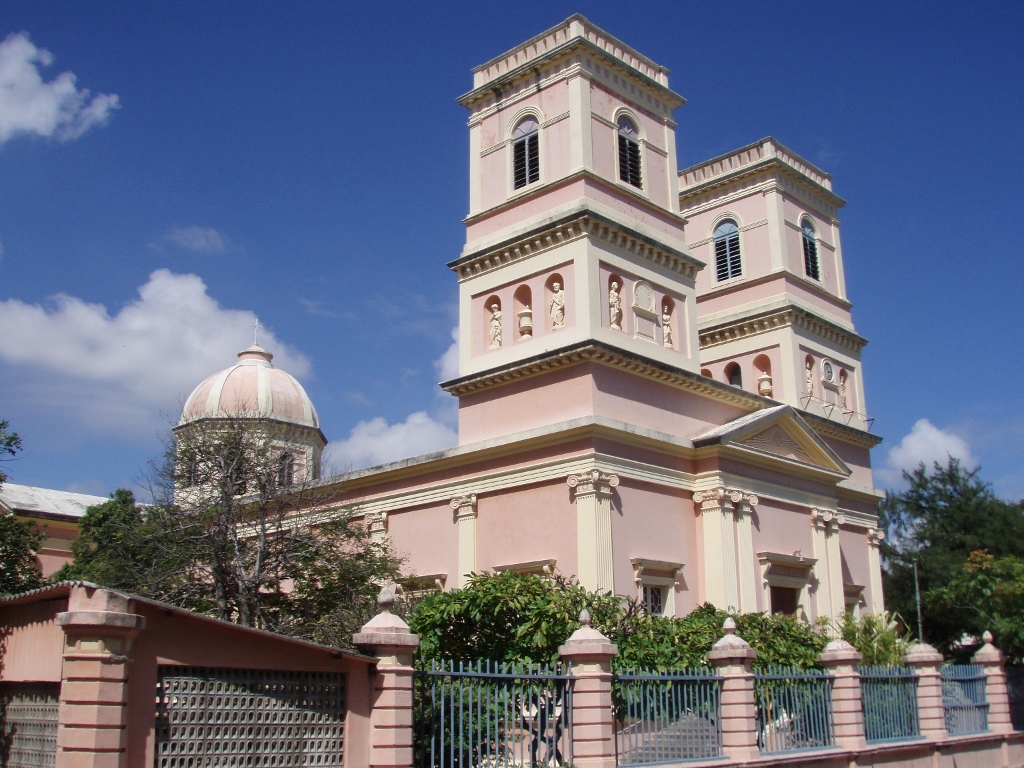 Church of Our Lady of Angels in Puducherry
Church of Our Lady of Angels in Puducherry
While we were walking around the city we noticed something rather unusual, something which we thought we had not seen in any other cities and places in India we had already been to, and these were litter bins in the streets. It also seemed it was cleaner here than in other places. We did indeed see a homeless man who was sleeping on the pavement, but still everything seemed somehow tidier. The air also appeared incredibly clean; after all we had noticed that the previous evening when we were walking by the shore. At the time when we were strolling around the centre, there was not a lot of traffic at all, so perhaps this is the reason for such impressions we had.
Then we also went to the central park that is located in the spot that used to be called the Government Square on account of the numerous government buildings that surround it, but it has changed its name too and is now called the Bharathi Park. In its middle, there is a pavilion called Aayi Mandapam which in its capacity of a monument celebrates the bringing of running water into the city during the times of the emperor of France, Napoleon III.
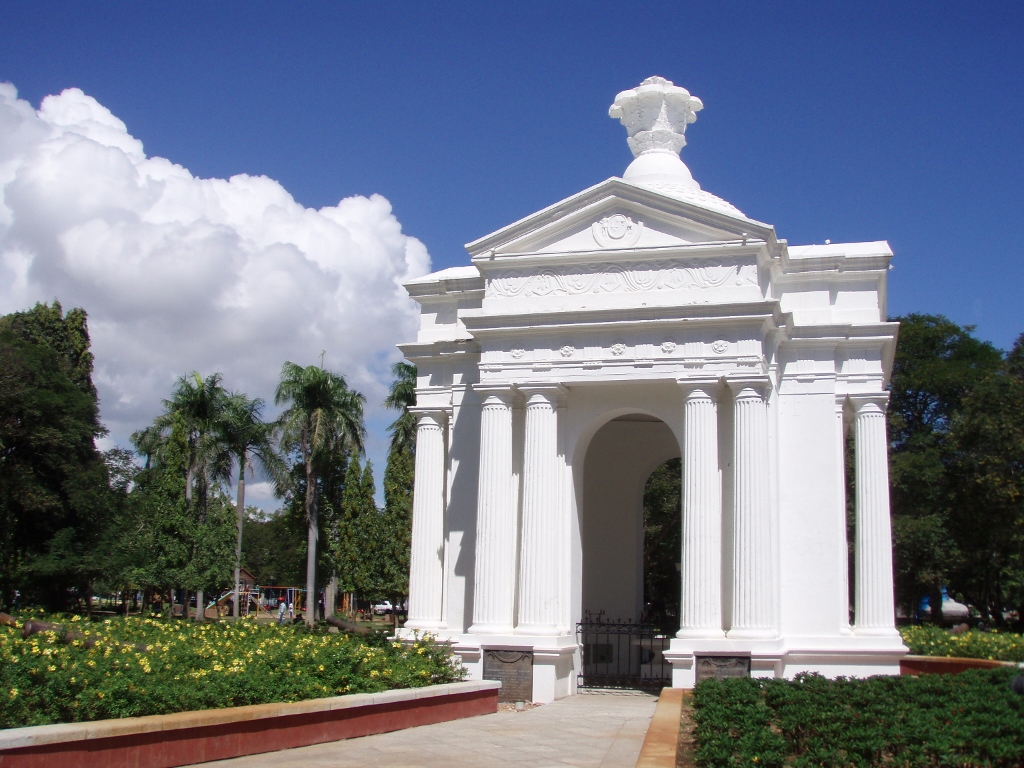 Aayi Mandapam
Aayi Mandapam
As it can be seen by the sky in the photos, we were quite lucky with the weather on this day and the humidity was lower than the previous days so we did feel certain relief in this sense.
While we were walking around the park, suddenly we heard some very nice sounds. I looked around and then I looked up, noticing large wind chimes. Somebody indeed tried to place them quite high and while the wind was drifting, they exuded some enchanting sounds.
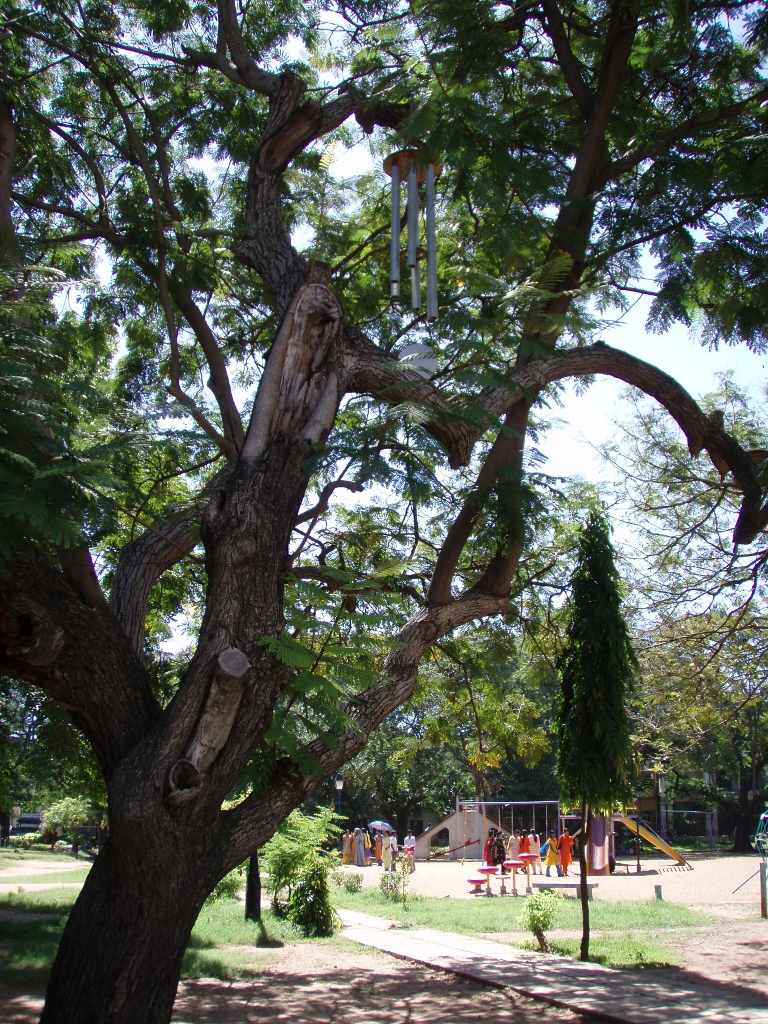 “Music” in the Bharathi Park
“Music” in the Bharathi Park
And then we walked again to the shore of the Bay of Bengal in order to see Mahatma Gandhi Statue in daylight. This is the tallest statue of Mahatma Gandhi in Asia and it is 4 metres tall, while around it there are eight granite pillars.
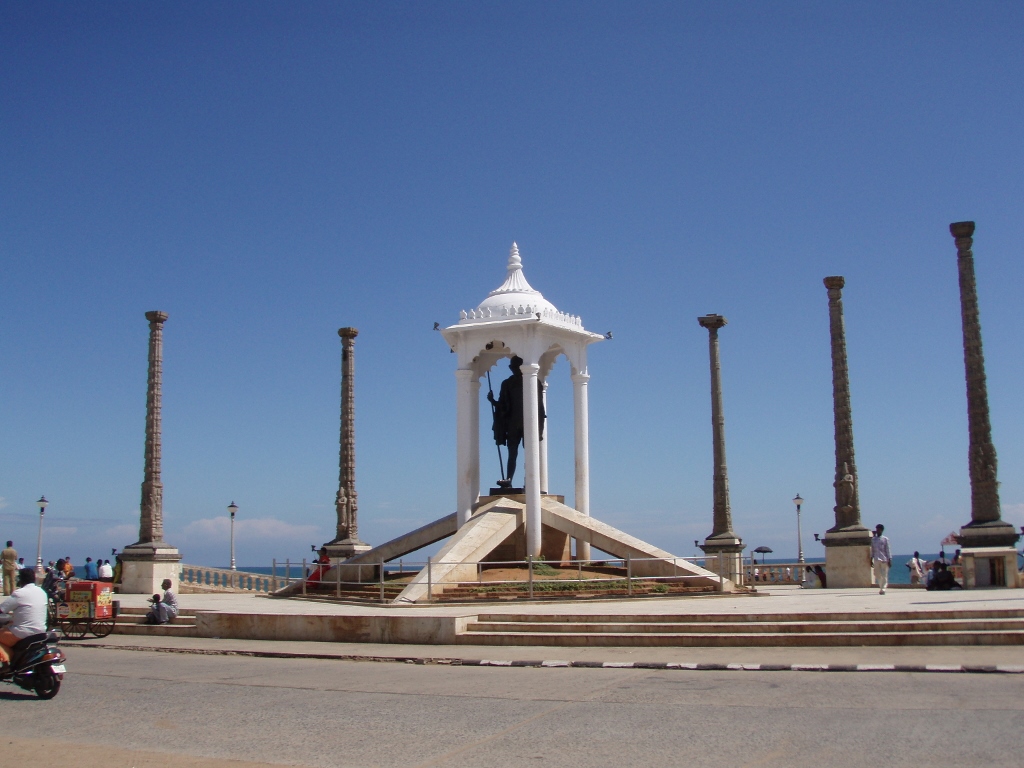 Mahatma Gandhi Statue
Mahatma Gandhi Statue
There we took the advantage of the nice and pleasant weather and walked a little bit more by the waters of the bay, since there is a walking area that is around 3 km long in total.
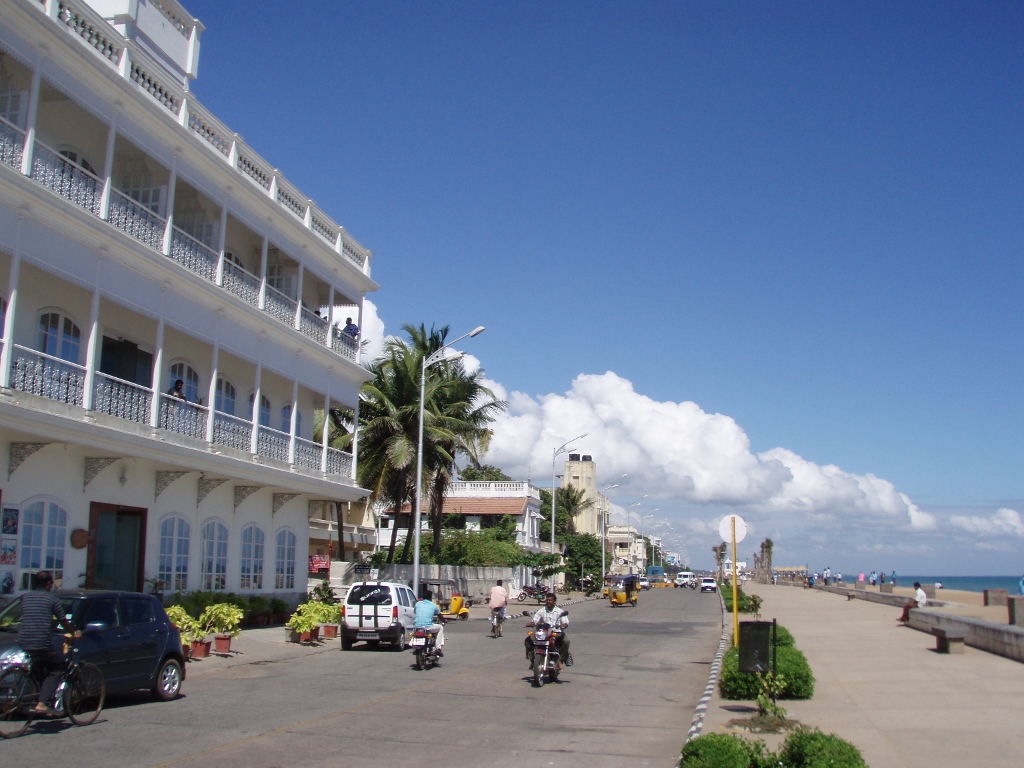 Street and the walking area by the Bay of Bengal
Street and the walking area by the Bay of Bengal
In December 2004, the tsunami created by the underwater earthquake in Indonesia reached the shores of mainland India, in the meantime hitting Indian Andaman and Nicobar islands (actually two archipelagos) that were closer to the epicentre. According to the official estimates, over 10,000 people were killed, while almost 6,000 are considered missing. The previous day we met a man who had worked with the people directly affected by the tsunami, either their family members were killed or went missing, or their property was destroyed, or both. As he told us, at the time we were there (year 2007), everything concerning the reconstruction of the properties, i.e., the houses had been finished, but there was still a huge problem linked to the psychological assistance which the surviving family members still needed.
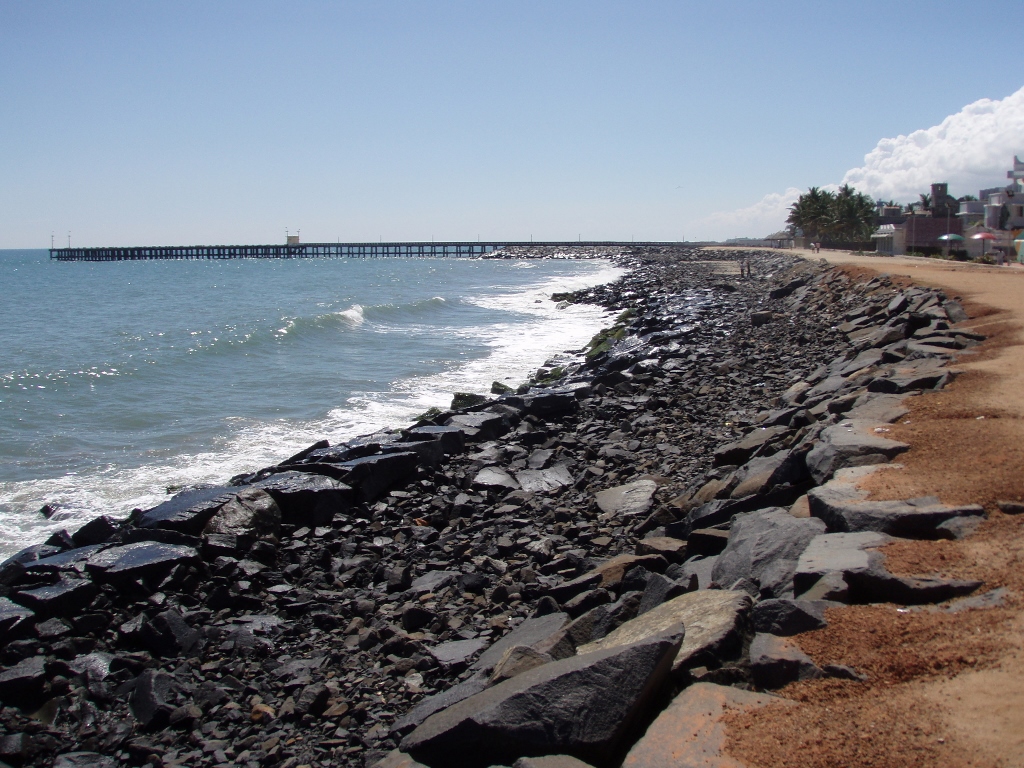 Shore of the Bay of Bengal in Puducherry at the time when the waters are calm
Shore of the Bay of Bengal in Puducherry at the time when the waters are calm
Although there are other interesting things to see in Puducherry, Sneža and I had to go back to our room in order to get ready for the afternoon excursion for which we had already booked a taxi ride.
In the courtyard of the boarding house we noticed a small Ganesha, a deity with the elephant head. (For the story about Ganesha see: https://www.svudapodji.com/en/india-7/) Since that is the god of abundance, success, auspicious circumstances and good events, a lot of homes have him as their protector and in addition to the offerings placed around him and the decorations with different elements, very often incense sticks or oil lamps are lit in front of him, like the one that can be seen in the photo.
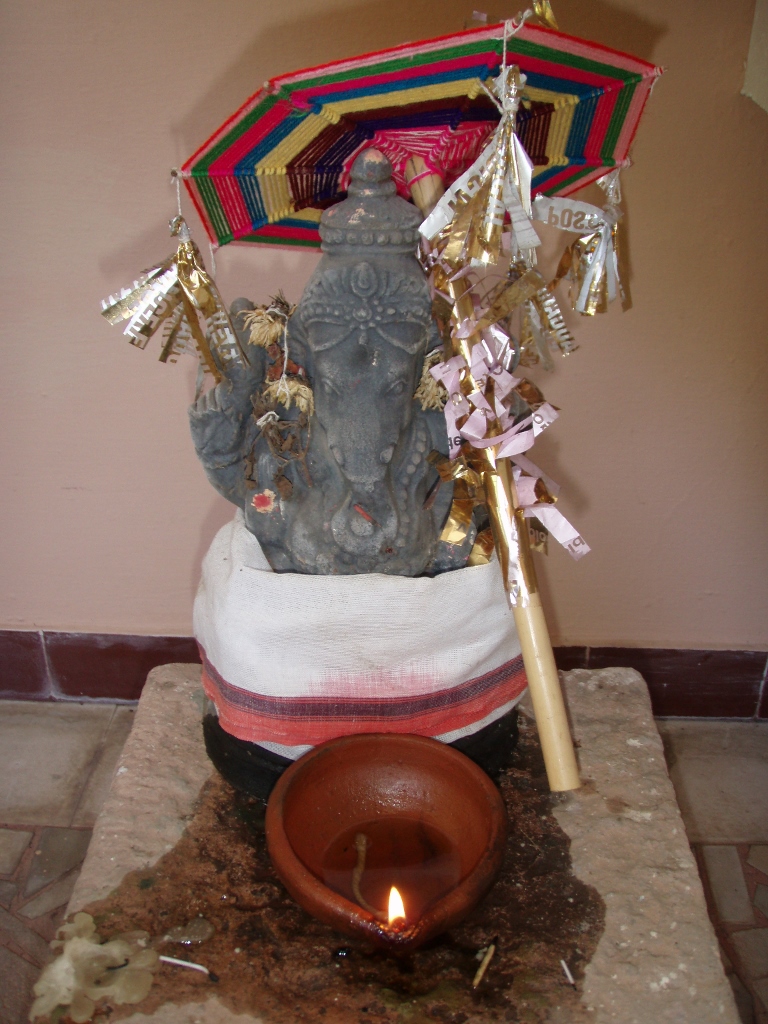 Ganesha
Ganesha
So, on this day, we went westwards by a rented taxi with an intention to reach the city of Tiruvannamalai that is some 100 km away from Puducherry, while also making a couple of breaks along the way.
The road led us through numerous villages and since there are usually crowds or there are traffic lights in such places, the car either moved very slowly or had to stop completely, thus making it easier for me to take photos from within. I appreciated this in particular since there are a lot of markets beside the road and they are always and everywhere colourful and picturesque.
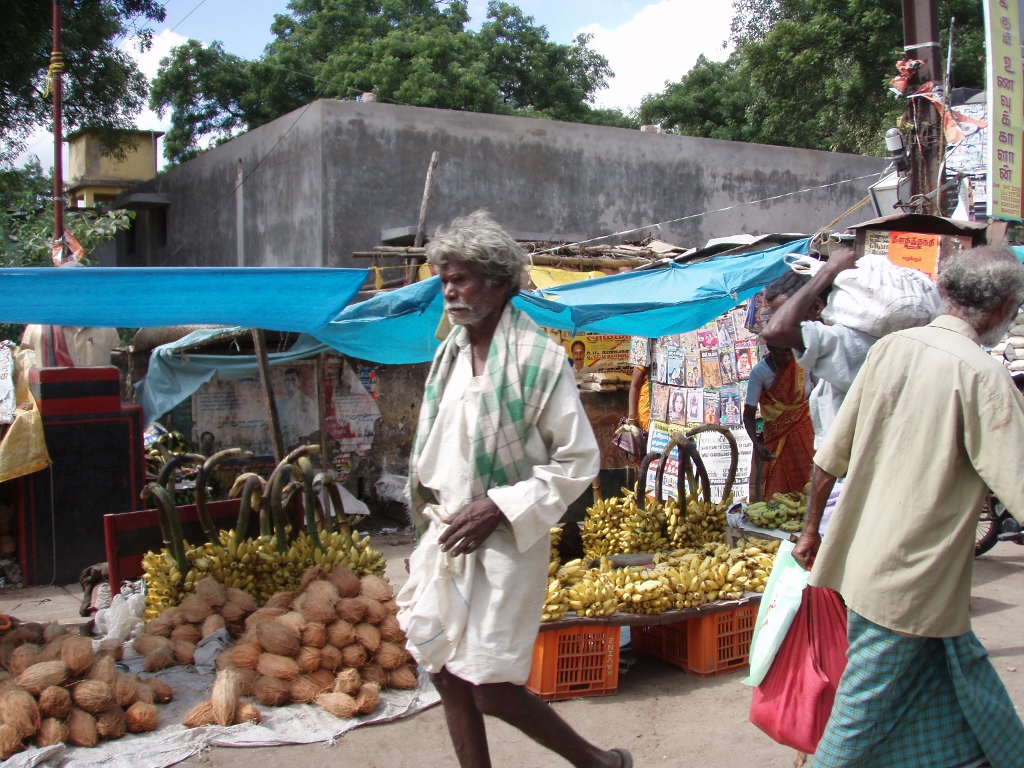 Detail from a market in the federal state Tamil Nadu
Detail from a market in the federal state Tamil Nadu
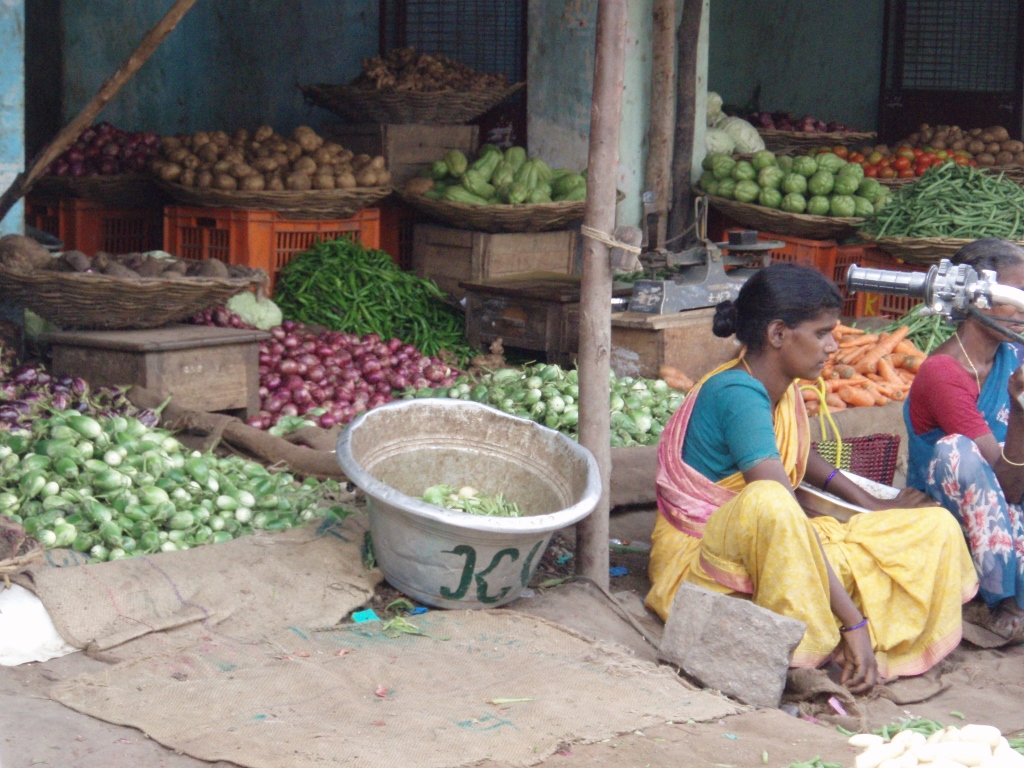 Detail from a market in the federal state Tamil Nadu
Detail from a market in the federal state Tamil Nadu
Although cows are sacred animals for the Hindus who account for around 80% of the population in India and are frequently seen in the streets where they freely and casually roam between pedestrians and vehicles, that certainly does not mean that these cows do not have their obligations. The Hindus may not eat beef, but the obligations of cows (and oxen) include everything from pulling carts, working in the field, as well as providing milk which is, among its other uses, processed to get ghee, the Indian version of butter that is cleaned from all milky elements. It is precisely that diversity in the use of the cows and well as their mild nature that have led the Hindus to consider them a sacred animal, as well as the personification of the motherly love.
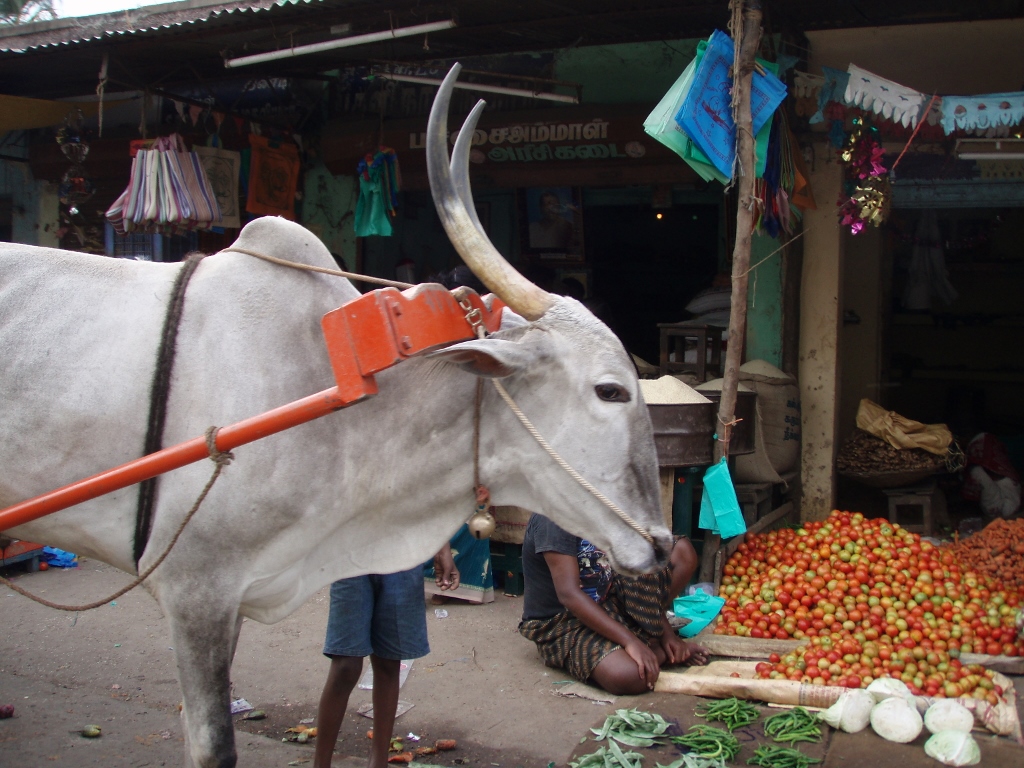 Typical Indian bovine seen in a market
Typical Indian bovine seen in a market
Since I’m mentioning animals and meat, let me say something about the food and what kinds of meat can be eaten in India. Of course, if you are a vegetarian and like spicy food, India is then the right place for you. But, if you do eat meat, the easiest thing is to eat chicken which is universally found in the menus throughout the country. The Hindus do not eat beef, but they eat pork which is not eaten by the Muslims (some 14% of the Indian population), but the latter can eat beef. I personally eat meat and I like spicy food, and I also love Indian food, but somehow during this journey I would usually end up eating “veg noodles,” since my favourite food are carbohydrates, plus I love vegetables as well.
In one of the villages we were passing through we made a break and Sneža went to buy us some water, while I was standing and waiting under some trees. There I saw several monkeys that were jumping in the treetops and then I felt something was falling all over me. I looked up to see what it was and I realised there was a monkey sitting in the treetop above me and it was eating something throwing away all the husks and then these husks were falling on me. What an impertinent relation towards visitors! Typical monkey business.
Still, while I was dealing with these monkeys taking photos of them, I was approached by some women who expressed a desire to have their photo taken. I certainly granted them the wish with a lot of joy.
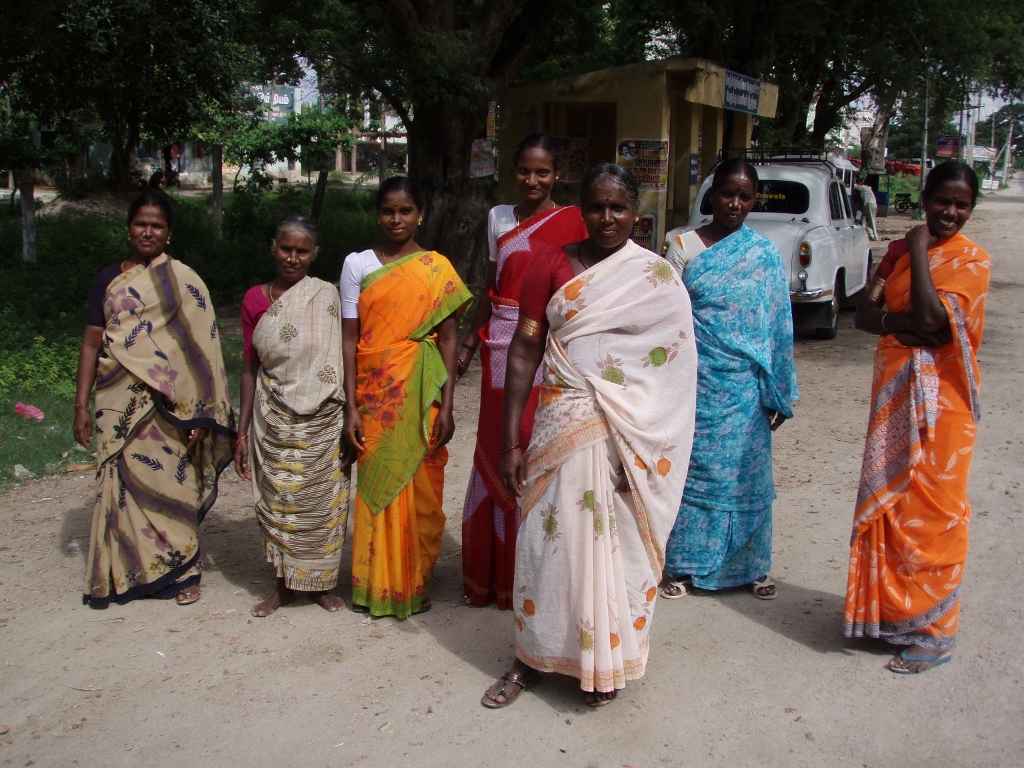 Indian women
Indian women
On our way to Tiruvannamalai we stopped at the Gingee Fort, which is also called Senji Fort. Namely, in the middle of a vast plain in this part of the federal state Tamil Nadu, there are three hillocks and they provide an exceptional strategic position for the control and observation of the entire broad area. This was, of course, noted a long time ago and the original forts built on the hillocks were first maintained by representatives of the Chola dynasty (the same ones who built Brihadishvara Temple in Thanjavur, see: https://www.svudapodji.com/en/india-15/), while they were fully developed and additionally fortified by rulers from the Vijayanagara Empire (they are mentioned in parts 7 and 8 of the story about India, when I talked about our visit to Hampi, the capital of the empire). After the 17th century when the Vijayanagara Empire disappeared, this area was in the hands of different rulers, including the French and the British. The fort is so impressive and strong that the formal founder of the Maratha Empire, Chhatrapati Shivaji (see: https://www.svudapodji.com/en/india-1/), declared at some point that this was the most unconquerable fort in all of India, while the Brits called it the Troy of the East.
As I’ve said, the fort consists of three parts, one on each hillock, but it is necessary to climb to these forts, that is, to their remains and Sneža and I were being driven along the plain. By the way, our main destination for the afternoon was a very important temple in Tiruvannamalai and our time was limited. In other words, we contented ourselves by looking at the part of the fort and the remains of the walls at the foot of Rajagiri hillock, as well as by having a short stroll around a pond near which our driver parked the car.
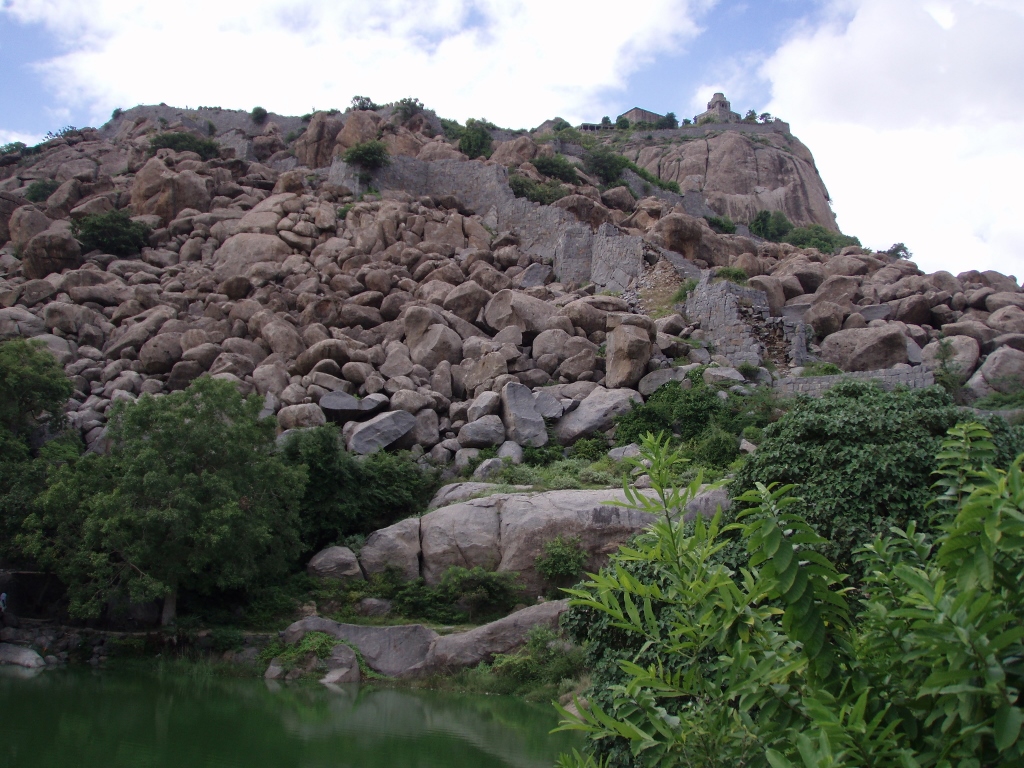 Rajagiri hillock: remains of the fort are on the top, while the remains of the walls can be seen on the slope
Rajagiri hillock: remains of the fort are on the top, while the remains of the walls can be seen on the slope
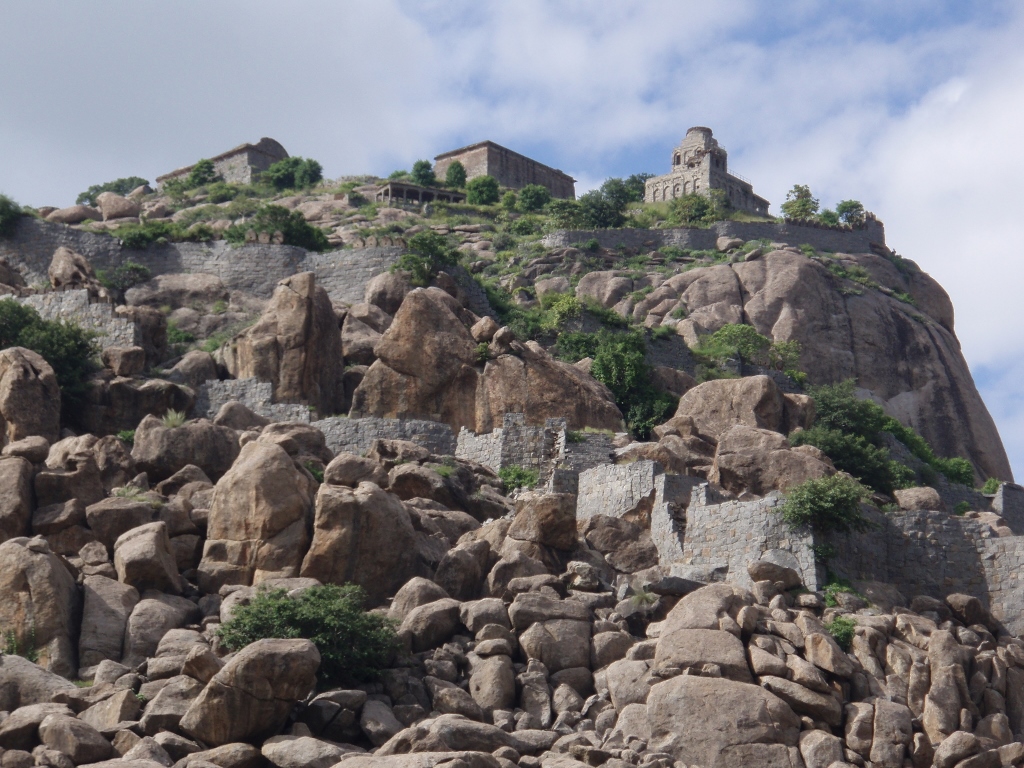 Rajagiri hillock with the remains of the fort and the walls
Rajagiri hillock with the remains of the fort and the walls
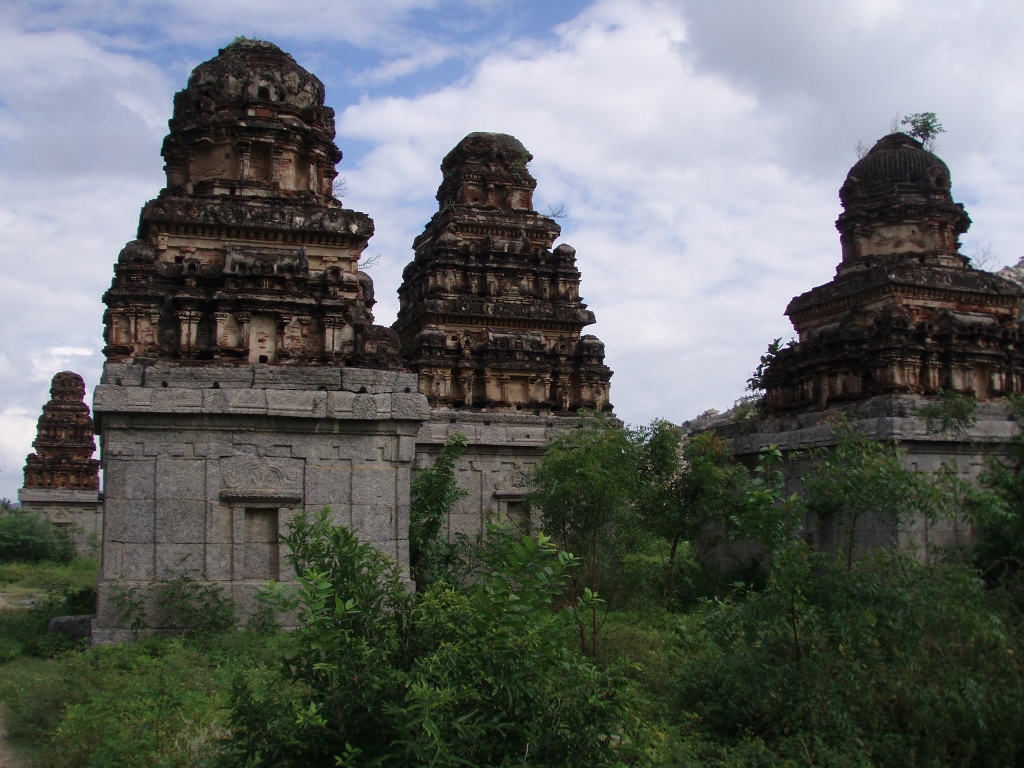 Structures close to the pond
Structures close to the pond
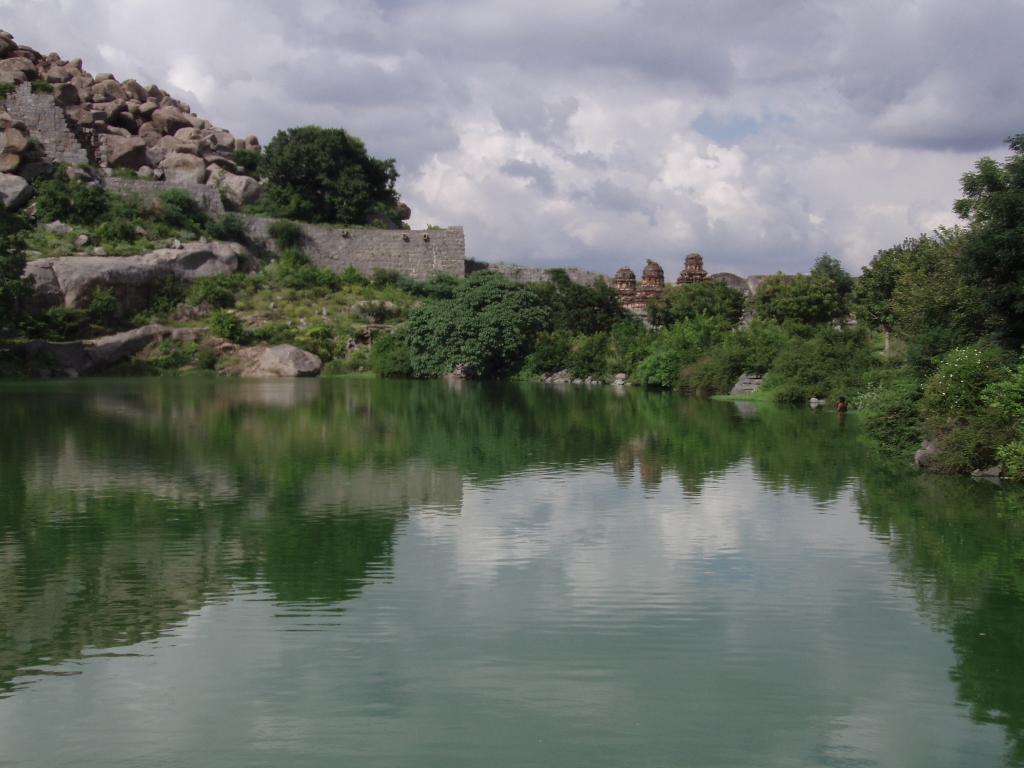 Pond at the foot of Rajagiri hillock, remains of the walls and structures close to its shore
Pond at the foot of Rajagiri hillock, remains of the walls and structures close to its shore
Right next to this pond there is the small Anjaneyar Temple, but we visited it quite quickly and then moved on to another, slightly bigger pond that is also located in the vicinity.
If you pay close attention, in the photo above you will see a man swimming in the pond and by the time we had reached the bigger pond, another man had already finished his bathing under the watchful eyes of a family of monkeys.
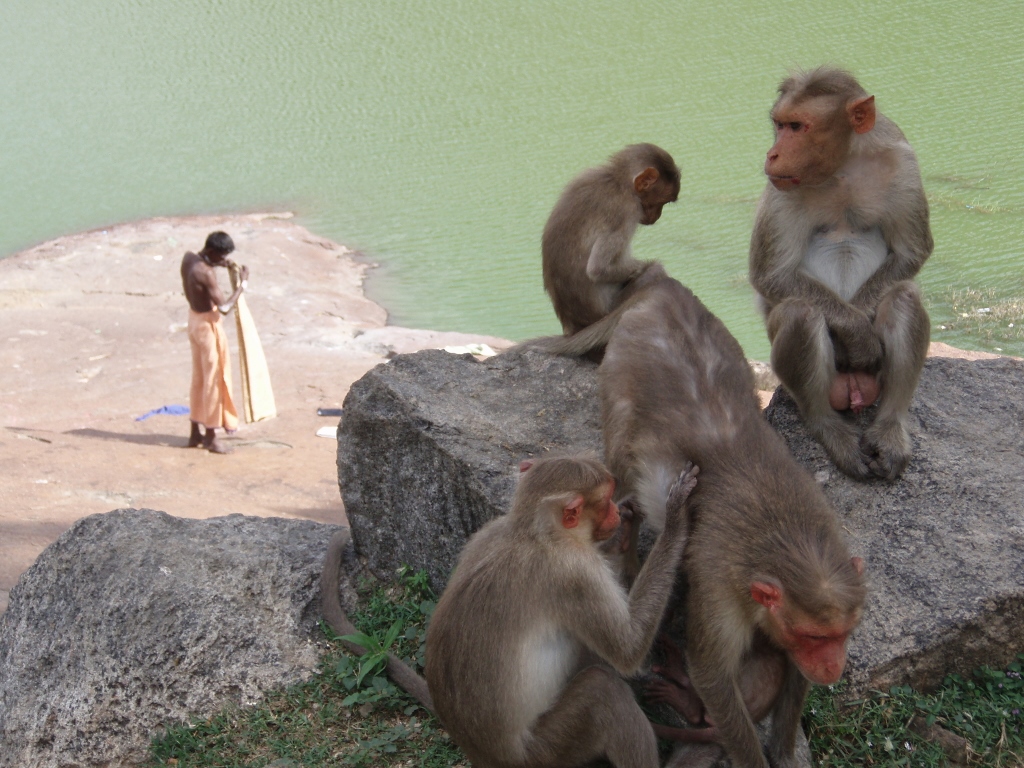 The bathing is over
The bathing is over
From the shores of that other pond a little farther away we could see a gopuram (decorative tower that rises above the entrance into a temple) and then we also drove to that temple. This was Venkatramana Temple from the 16th century that is also the biggest temple in Gingee, but we did not stay there for too long either.
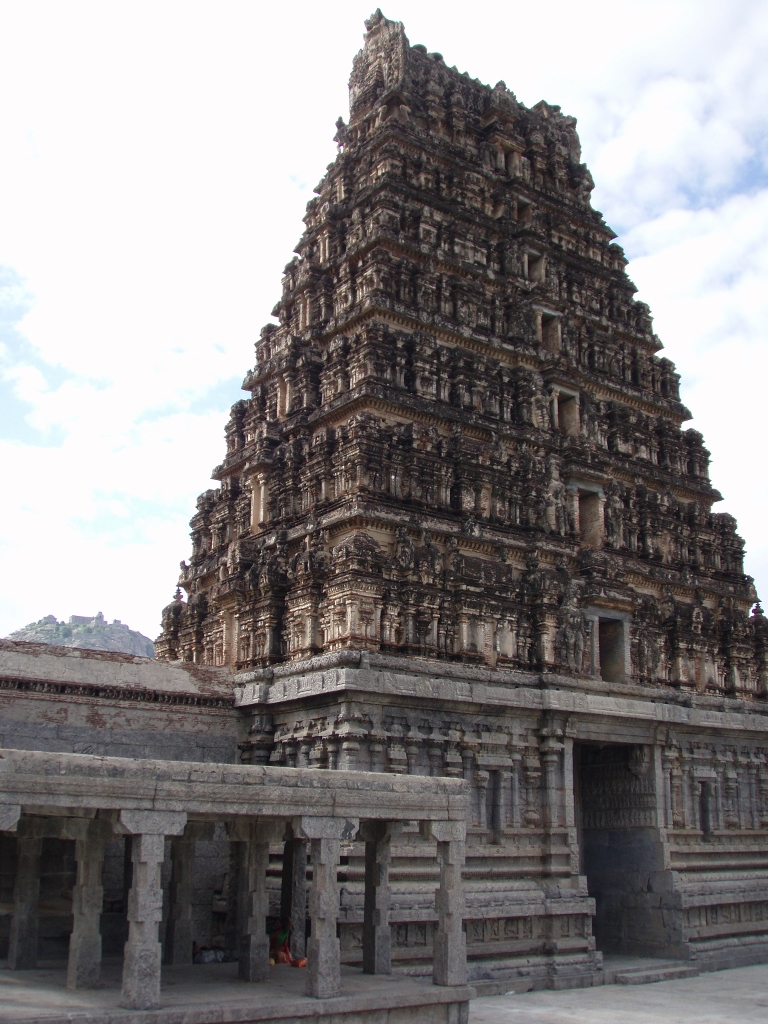 Gopuram of Venkatramana Temple; in the distance to the left it is possible to see the top of Rajagiri hillock with the fort
Gopuram of Venkatramana Temple; in the distance to the left it is possible to see the top of Rajagiri hillock with the fort
I must admit that after the huge number of temples we had already seen during our stay in India, one more temple could not make such a major impression. I actually preferred another, completely different sight and that was a rice field in the middle of which there were banana plants.
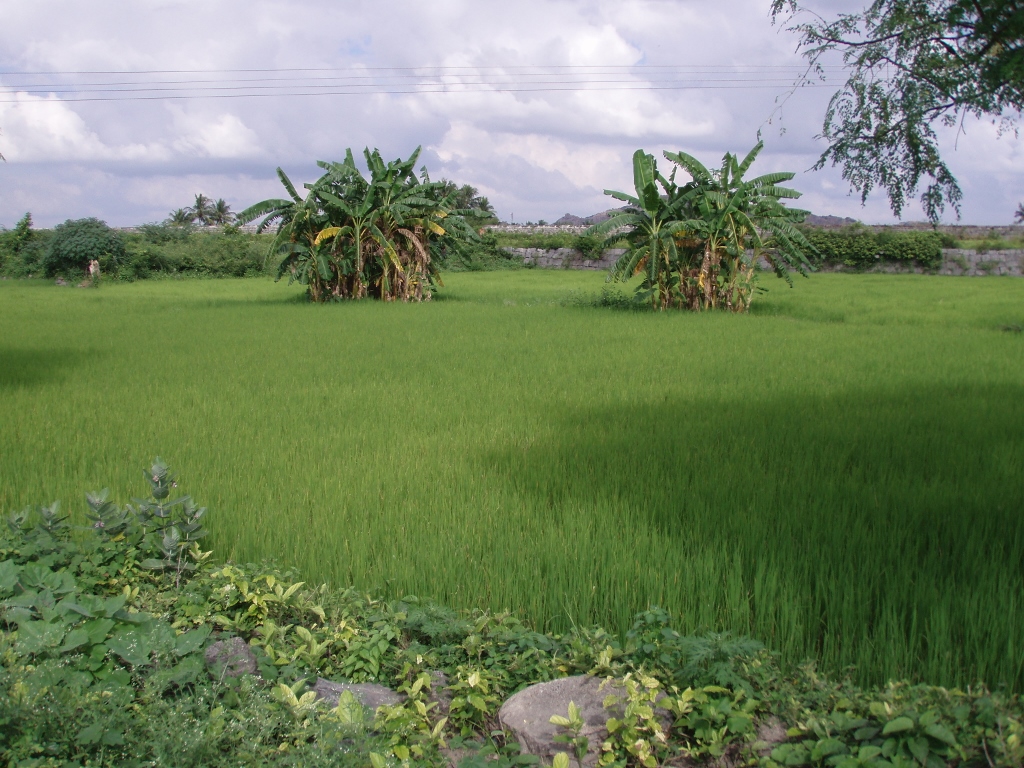 Rice field with banana plants
Rice field with banana plants
There I also took an opportunity to make a photo of an impressively large banyan tree, as well as of the car in which we drove that day. They are both interesting in their own right.
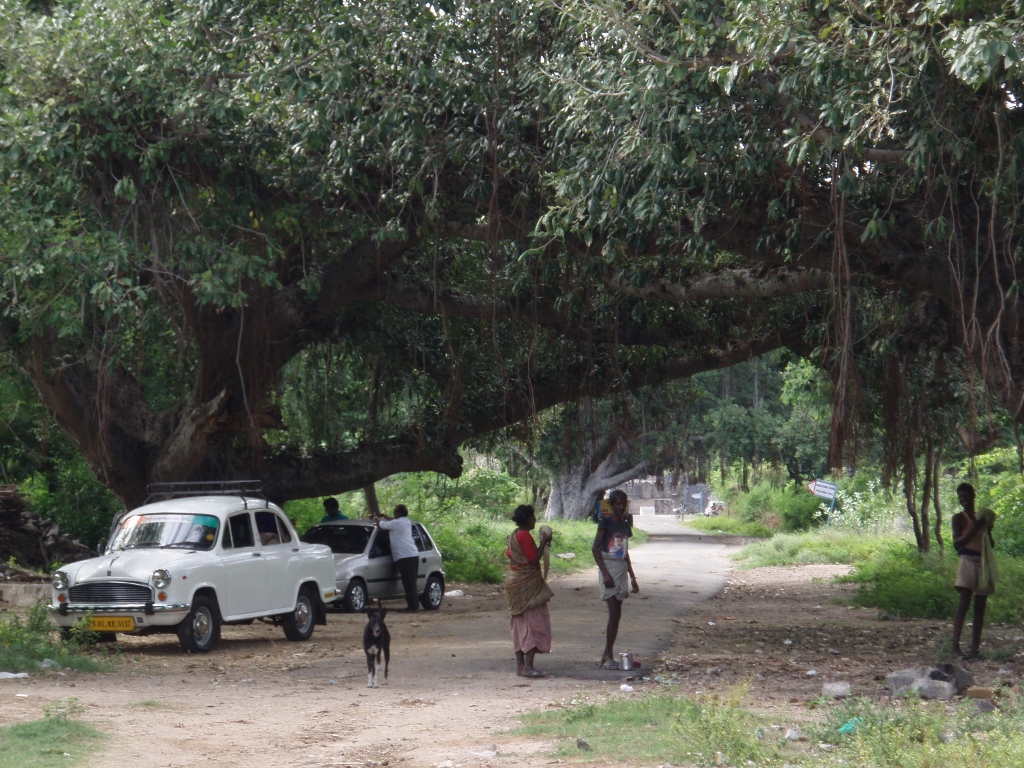 The white car in the foreground is “ours,” while in the background there is the huge banyan tree
The white car in the foreground is “ours,” while in the background there is the huge banyan tree
First – the tree. This is a type of fig tree and when the news report that some statesman visiting India “planted a fig tree”, they never think of the simple edible fig (Ficus carica), but rather of another kind of tree from the ficus genus. There are of course several species coming from this same genus and the one in the photo is Ficus benghalensis which is among other things characterised by aerial roots which like hairs grow down from its branches. It is also interesting that this genus includes some plants that are grown as houseplants in Europe: weeping fig (Ficus benjamina) and rubber fig (Ficus elastica, subspecies Robusta). I actually think that English word for fig has its origin precisely in “ficus.”
Second – the car. This was Hindustan Ambassador and the model is often called the “national car of India.” The vehicle has British origin, but this was the first passenger vehicle manufactured in India and manufactured indeed it was and for quite some time – from 1958 until 2014!
Leaving Gingee, we passed by many other parts of the fortification that are located in the flatland, we saw some more remains of temples, as well as a 7-storey building called Kalyana Mahal, but many of these segments were undergoing renovation and therefore access to them was prohibited, plus we still had to reach Tiruvannamalai.
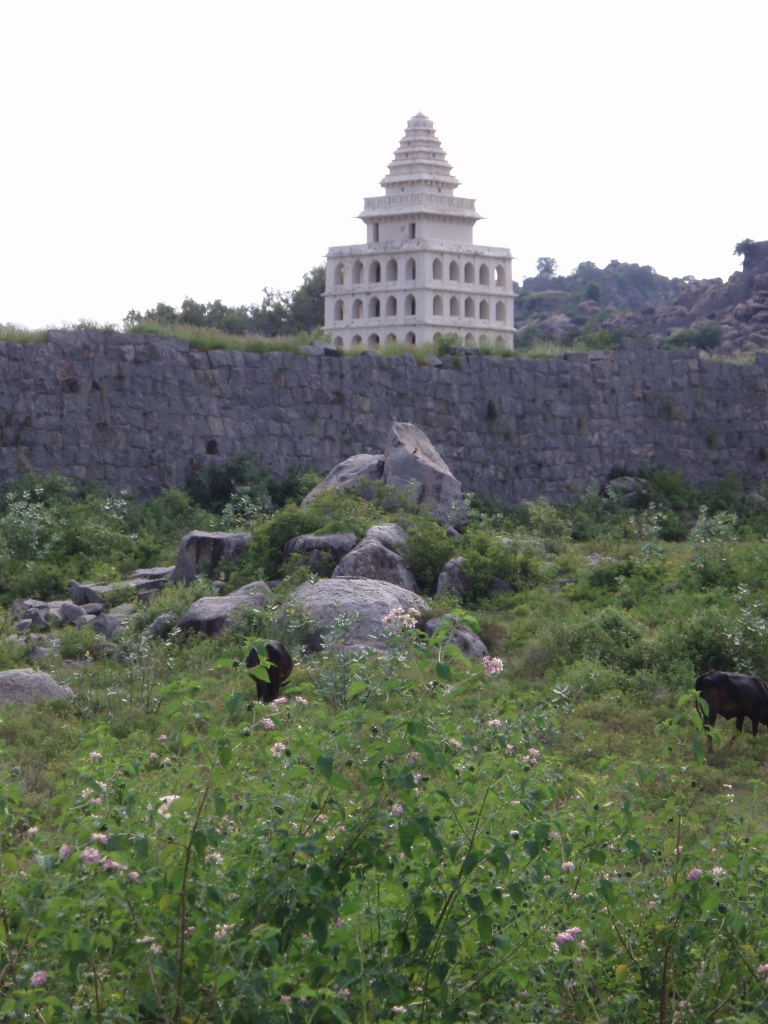 Kalyana Mahal
Kalyana Mahal
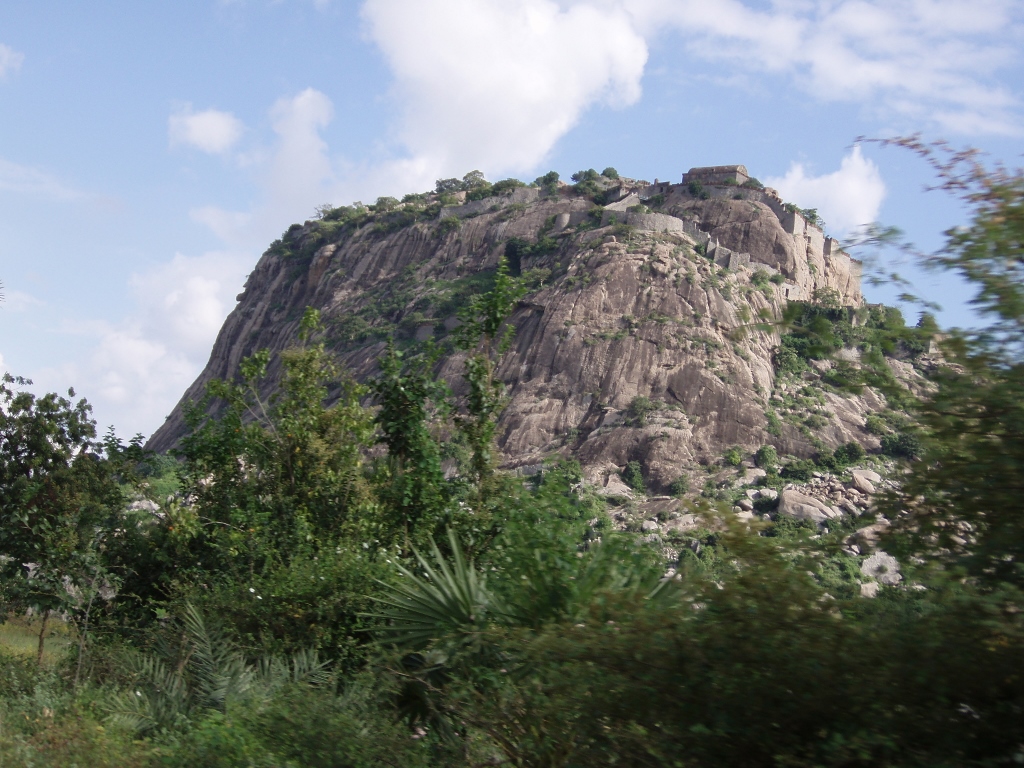 One more look at the Gingee Fort on top of Rajagiri hillock
One more look at the Gingee Fort on top of Rajagiri hillock